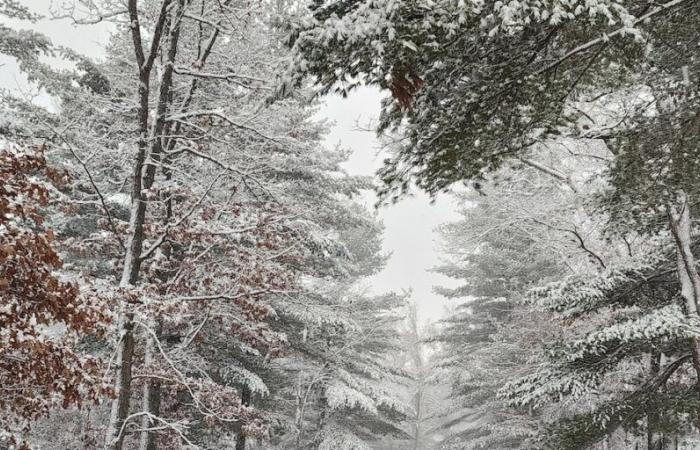MADISON, Wis. (WMTV) – The week of Nov. 18-22 is Winter Weather Awareness Week in Wisconsin.
People are encouraged to become more aware of the dangers that winter weather can pose in this part of the country. Hazards include not only heavy snow and blizzards, but also extreme cold, high wind, freezing rain and drizzle, dense fog and in
As your First Alert Weather Team, it’s our goal to give you a heads-up about impactful weather as far in advance as possible. However, that comes with guidelines, especially in the winter when the forecast can shift a lot in just a few days. Here’s our general timeline for forecasting winter storms.
About a week out, we’ll begin to see some loose patterns in the model data that show the possibility of a storm. At four to five days out, those trends begin to align. This is when we gain confidence on whether or not this system will impact southern Wisconsin, and we’ll issue an Alert Day to bring it to your attention.
When we’re two to three days out, the path of the system begins to solidify and we can talk more about precise timing and start to talk about snow totals. At one to two days out, our confidence grows and we can narrow the forecast down to a more local level.
You can see how our process is like a funnel, narrowing in on the details as the event draws closer. Keep this in mind the next time you see a snow forecast on social media two weeks in advance.
Madison usually gets over 50 inches of snow every winter. The type of winter storm that brings us fresh snow can dictate what type and how significant of impacts we see. As meteorologists, we look at where the storm system comes from to clue us in on those details, and you the most accurate forecast possible.
The first type is a Colorado Low. A storm system that forms over the four-corners region typically carries a lot of moisture from the West Coast or the Gulf Coast.
The path of these storms is really important because they usually carry milder air. Colorado Lows can give us a big dumping of snow, or if it shifts too far north it can leave us with a wintry, slushy mess.
The second storm type is an Alberta Clipper that comes in from western Canada. By the name, these storms move through quickly and since they’re coming from the north, they usually carry a lot of cold air.
This can lead to smaller amounts of fluffier snow. It’s common to see temperatures plummet after an Alberta Clipper moves through.
As we continue through Winter Weather Awareness Weekit’s important to understand the different types of alerts issued by the National Weather Service (NWS) during the winter months. These alerts help keep you informed about upcoming snow, hazardous precipitation like ice, or dangerously cold temperatures.
The NWS categorizes these alerts into three levels based on three main factors: the likelihood of the event occurring, the potential impact it could have on your daily life and the amount of snow.
- An Advisory is issued to let you know that potentially dangerous winter weather is expected in the next 12 to 36 hours. While these conditions may not be extreme, they can still make travel difficult or hazardous. Think of an advisory as your early heads-up to stay cautious.
- A Watch means conditions are favorable for significant winter weather, but it’s not guaranteed yet. Watches are typically issued 36 to 48 hours in advance. This is your time to prepare—check your supplies, plan your travel, and keep an eye on the forecast as more details emerge.
- A Warning is the most urgent alert. It indicates that dangerous winter weather is expected within the next 12-36 hours. For example, a Winter Storm Warning means heavy snow, ice, or other hazards will likely cause considerable traffic problems and disruptions.
So next time you see these alerts issued, just remember that an advisory gives you the first hint that winter weather is coming, and that a warning is just like it says, a more immediate notice that the winter weather is here or just about to arrive.
By understanding these terms, you’ll be better equipped to stay safe during the winter season. So next time you see an advisory, watch, or warning pop up, you’ll know exactly what steps to take!
Stay informed, stay safe, and let’s get through this winter together.
As temperatures drop and winter storms roll in, you may hear the term “wind chill” mentioned in weather forecasts. Also known as the “feels-like” temperature, wind chill is a measure of how cold it feels on your skin when you combine the actual air temperature with wind speed.
But what does wind chill really mean, and why does it matter?
Your body naturally radiates heat, creating a thin layer of warm air just above your skin. This acts as a natural insulation, especially when the wind is calm. However, when the wind picks up, it blows that warm layer away faster than your body can replace it.
The stronger the wind, the more heat your body loses—and the colder it feels. For example, if the thermometer reads 20°F but the wind is blowing at 20 mph, it feels more like 4°F on your skin. This explains why a cold, windy day feels so much harsher than a calm one.
Wind chill doesn’t just make you uncomfortable; it can also be dangerous. When wind chills reach extreme levels, the risk of frostbite and hypothermia increases significantly. Frostbite can occur on exposed skin in as little as 30 minutes when wind chills drop to -15°F or lower.
This is why it’s crucial to dress appropriately for cold weather. Layers of clothing, hats, gloves, and scarves can help retain body heat and protect exposed skin.
Here’s an important point to remember: Wind chill only affects living things, such as people and animals. It won’t make inanimate objects, like your car or house, colder than the actual air temperature.
As we observe Winter Weather Awareness Week, keep wind chill in mind when planning outdoor activities. Protect yourself and your loved ones by bundling up and staying warm.
Stay safe, stay informed, and enjoy the winter season responsibly!
Click here to download the WMTV15 News app or our WMTV15 First Alert weather app.
Copyright 2024 WMTV. All rights reserved.






